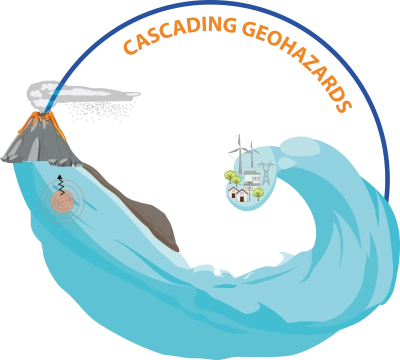- Home
- Our Research
- Natural and Environmental Hazards
- Cascading geohazards
Cascading geohazards
Nearly half of Europe’s population lives in coastal regions and this number is increasing. The high population density along our coasts and the expected growth of complex critical infrastructure and Ocean services in coastal regions lead to mounting levels of exposure and vulnerability to marine geohazards. Marine geohazards pose a significant threat to the European coastal population and to the development of the Blue Economy that currently account for 1.5% of the economy and 2.2% of employment. As a result, the DAM has launched the Research Mission mareXtreme to study various of those hazards in European waters. These include geohazards, but also biohazards and meteorological and oceanographic hazards (www.marextreme.de).
All these hazards have in common that study of the individual hazard usually underestimates the oftentimes dramatic cascading effects. Cascades and cumulative events are multi-hazard chains where a triggering process leads to other phenomena, resulting in additive or multiplying impacts that significantly increase fatalities and damage. The cascade effect projects into an unpredictable chain of events, with a domino effect where an initial hazard causes another event, which in turn may trigger another in a linear sequence and all their impacts add up. For a cumulative hazard the impact multiplies and thus significantly magnifies. This effect may be solely natural (e.g. earthquake à landslide à tsunami), but may also be technological and induced by mankind (e.g. tsunami à flooding of infrastructure à meltdown of nuclear power station/broken gas lines cause fires/etc.). Such cumulative hazard cascades pose barely foreseeable risk, but require quantification for infrastructure construction, re-insurance companies, etc.
In the project MULTI-MAREX, PIs from MARUM work on various geohazards in the Eastern Mediterranean Sea, the area in Europe where seismicity is highest and many coastal communities are extremely vulnerable, in particular in summer with millions of tourists visiting. The project studies volcanic, seismic and tsunamigenic hazard, but also sheds light on sedimentary seafloor hazards such as submarine landslides, active mud volcanoes, and other mass transfer events. Among the goals of the MARUM researchers are the numerical simulation of slope failure (Huhn, Bartzke) and the development of seafloor instruments that are capable to eventually issue early warnings of hazards (Kopf, Menapace).
The European Training Network POSEIDON (www.poseidon-dn.eu) funded within the Marie Skłodowska-Curie Actions programme brings together MARUM scientists (Huhn, Gatter) with experts from European countries, universities, research institutions, industry partners and government agencies to investigate submarine geohazards. Together, they will offer a new generation of doctoral candidates a chance to equip themselves with the tools to identify, map, assess, and predict offshore geohazards. Their mission is to unearth innovative methods to safeguard, strengthen, and foster resilience in our offshore infrastructure, all while navigating the tumultuous waters of climate change.



